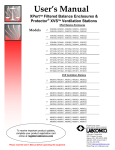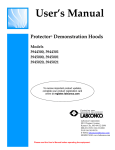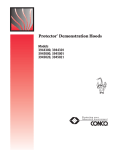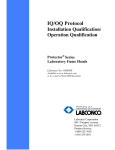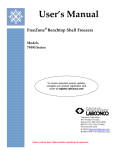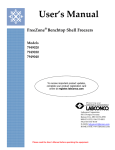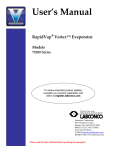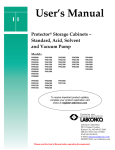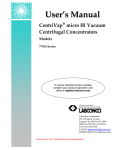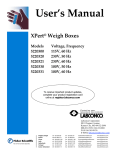Download Guardian 1000 Digital Airflow Monitor Installation Guide
Transcript
LABCONCO CORPORATION 8811 Prospect Ave, Kansas City, MO 64132 (816) 333-8811, Fax (816) 363-0130, (800) 821-5525 Guardian™ Digital Kit No 3908800, 02 or 3908801, 03 Guardian Digital 1000 Operation The Guardian Digital Airflow Monitor consists of the airflow sensor, the Alarm Unit and the 15 VDC power supply. For 115V operation the alarm unit is powered by plugging the power supply into the factory-prepared digital airflow monitor socket. For 230V operation, the Alarm Unit is powered by plugging the power supply into a building outlet. The alarm has “Enter”, “+”, and “-” buttons to program the monitor. There is also a green LED “SAFE”, yellow LED “CAUTION”, and red LED “LOW” with audible alarm for airflow conditions. The audible alarm can be permanently muted if desired. The Guardian Digital 1000 Airflow Monitor displays a face velocity value, provides an RS232 communications port to a PC or building computer system, can be configured for external input connections such as night setback or external alarm and provides up to three output relays that can be configured. For complete detailed information, please refer to the separate Labconco 1000 Alarm User’s Manual provided with the enclosure. Installation Procedure 1. The enclosure comes prepared to except the Guardian™ Digital airflow monitor system. 2. First remove the large 1.19" dia. gray hole plug. See Figure 1. See Figure 2 only to reference internal assembly of the airflow monitor. Locate the elbow, locknut, and washer and install it in the 1.19" dia. hole per Figure 1 and Figure 2. The enclosure baffle pivots down to install the elbow, washer and locknut. 3. Cut the 1" hose supplied with the kit to 10.5" approximate length and install it between the airflow sensor and the elbow. 4. Secure the Guardian Digital alarm to the enclosure with double stick tape as shown in Figure 3. The airway passage between the alarm module and the enclosure is now complete. 5. Locate the metal hose cover and install with double stick tape per Figure 3. (Omit this step on the Protector Work Stations.) 6. Locate the power supply transformer. One end should already be connected to the twopin connector labeled 15 VDC on the back of the alarm module and through the strain relief bushing. If disconnected, then reconnect to power the airflow monitor. Plug the 115V power supply into a standard 115V duplex receptacle, the back of the accessory FilterMate portable exhauster or the back of the accessory light. For 230V, plug into a standard receptacle with your specific outlet plug. (It is recommended that the airflow monitor be connected directly to the FilterMate switched auxiliary outlet so the airflow monitor is powered at the same time.) 7. Installation is now complete. Labconco Instruction Sheet 3909400, Rev. F, ECO F288 1 of 7 Remove Large 1.19" Dia. Hole Plug Install Elbow, Locknut and Washer Figure 1 Hole Plug and Mounting Screws Location Airflow Sensor Display Digital 1000 Monitor Figure 2 Digital 1000 Airflow Monitor Details Labconco Instruction Sheet 3909400, Rev. F, ECO F288 2 of 7 Accessory Light Enclosure Hose Cover Monitor Figure 3 Digital 1000 Airflow Monitor Installation Labconco Instruction Sheet 3909400, Rev. F, ECO F288 3 of 7 Digital 1000 Calibration 1. Calibrate the airflow monitor according to the instruction manual that comes with the kit. To successfully calibrate, it will be necessary to change the face velocity by adjusting the airflow exhaust volume. The exhaust volume can be adjusted with the speed control on the FilterMate or by using an adjustable damper on the exhaust blower. Typical calibration conditions are set at face velocity air sample differences of at least 20 feet per minute. The airflow monitor is factory set to be calibrated with a difference of at least 50 fpm and can be changed by changing the “lower/higher air sample difference”. The following suggested in flow face velocity speeds are recommended to successfully calibrate. Typical low air alarms are set 10-20 fpm below operational speeds. Follow Step 2 below and review the Labconco 1000 Alarm User’s Manual that comes with the airflow monitor. Low Air Alarm Set Point 40 - 50 fpm 60 - 70 fpm 80 – 90 fpm Enclosure Operating In flow Speed 60 fpm 80 fpm 100 fpm Low Calibration Set Point 40 - 60 fpm 50 - 90 fpm 50 – 110 fpm High Calibration Set Point 100 – 120 fpm 100 – 150 fpm 100 – 170 fpm 2. Go to setup and then CAL CONFIG MENU and change the “lower/higher air sample difference” to 20 fpm. This will allow you to successfully calibrate with values of a minimum of 20 fpm difference. 3. While in CAL CONFIG MENU, change the “sensor difference” from 10% to 3%. 4. While in CAL CONFIG MENU, adjust the red low air alarm to the desired setting such as 55 fpm. Then adjust the yellow “CAUTION or WARNING” to 59 fpm. Then adjust the “CAUTION or WARNING” air reset to 3 fpm. This sets the alarm condition. 5. To complete the CAL CONFIGURATION, be sure to enter “DONE”. 6. To start the calibration mode, use the Labconco 1000 Manual and enter “CALIBRATION” mode on the display from the SETUP menu. 7. Follow the instructions on the display and alter the low exhaust volume with the speed control on the FilterMate or exhaust damper. Measure the average face velocity and enter the low value on the display. Be careful not to block the opening. The low exhaust volume calibration will take about 5 seconds. 8. Now alter the high exhaust volume with the speed control on the FilterMate or exhaust damper. Measure the average face velocity and enter the high value on the display. The high value must be at least 20 fpm greater than the low value. The high exhaust volume calibration will take about 5 seconds. 9. Be sure to enter “DONE” after successfully completing the low and high calibration set points. 10. Once calibration is completed, go to “RUN” and hit “ENTER”. The value should read close to the high calibration set point. 11. To lower the face velocity to the operating point, simply alter the exhaust volume with the speed control on the FilterMate or exhaust damper. Then recheck the face velocity with an anemometer to confirm the display on the digital airflow monitor. Labconco Instruction Sheet 3909400, Rev. F, ECO F288 4 of 7 Digital 1000 Alternate Calibration Procedure - Constant Volume Conditions 1. To successfully calibrate, it will be necessary to change the face velocity by opening and closing the enclosure’s sash. The airflow monitor is factory set to be calibrated with a difference of at least 50 fpm and can be changed by adjusting the “lower/higher air sample difference”. The in flow face velocity speeds provided in the chart below are suggested to successfully calibrate the Digital 1000. 2. Before proceeding with calibration, it will first be necessary to configure the airflow monitor. Go to the setup and then CAL CONFIG MENU and adjust the “lower/higher air sample difference” to 10 fpm. This will allow you to successfully calibrate with minimum difference values of 10 fpm. 3. While in CAL CONFIG MENU, change the “sensor difference” from 10% to 3%. 4. While in CAL CONFIG MENU, adjust the red low alarm to the desired setting (See the chart below for range and suggested settings). Then adjust the yellow “CAUTION or WARNING” to the desired setting (See the chart below for range and suggested settings). Then adjust the “CAUTION or WARNING” air reset to 3 fpm. This sets the alarm condition. CAUTION WARNING “YELLOW LED” Setting Range user defined (fpm) Suggested Set Point (fpm) 43 – 53 63 – 73 83 - 93 51 67 83 LOW ALARM “RED LED” Setting * Suggested Range user defined Set Point (fpm) (fpm) 40 – 50 60 – 70 80 - 90 48 64 80 Low Calibration Set Point Sash Open (fpm) 8” Sash 10” Sash Height Height 27 23 37 30 47 37 High Calibration Set Point or Enclosure Operating Inflow Speed Sash Closed 60 fpm 80 fpm 100 fpm * Because of airflow fluctuations in a typical laboratory environment Labconco suggests setting the “RED LED” low alarm set point to 20% below the enclosure’s operating speed. 5. To complete the CAL CONFIGURATION, be sure to enter “DONE”. If needed, refer to the Configuration procedure provided on the following page for additional details. 6. To start the calibration mode, enter “CALIBRATION” mode on the display from the SETUP menu. 7. Follow the instructions on the display and simulate the low exhaust volume by fully opening the sash. You may measure the average face velocity for the low calibration set point or utilize the calculated value provided in the chart above. The average face velocity for the low set point is accurately measured by dividing the opening of the enclosure into equal area grids consisting of at least 9 data collection points and measuring the velocity at the center of each grid with a calibrated thermo anemometer. Enter the low value on the display. Be careful not to block the opening. The low exhaust volume calibration will take about 5 seconds. 8. Now simulate the high exhaust volume by fully closing the sash to its normal operating position. Measure the average face velocity for the high calibration set point to confirm that the source of constant air volume is providing the desired face velocity for the enclosure. The average face velocity for the high set point is accurately measured by dividing the opening of the enclosure into equal area grids consisting of at least 3 data collection points and measuring the velocity at the center of each grid with a calibrated Labconco Instruction Sheet 3909400, Rev. F, ECO F288 5 of 7 thermo anemometer. Enter the high value set point on the display. The high value must be at least 10 fpm greater than the low value. The high exhaust volume calibration will take about 5 seconds. 9. Be sure to enter “DONE” after successfully completing the low and high calibration set points. 10. Once calibration is completed, go to “RUN” and hit “ENTER”. The value should read close to the high calibration set point. 11. With the sash fully open, the Digital 1000 monitor should go into “RED LED” low air alarm if successfully calibrated. Digital 1000 Alternate Configuration Procedure (for Constant Volume Conditions) Note: Enter Button stores information and +/- Buttons allow for scrolling. 1. Push the “ENTER” Button on the face of the alarm until the “SET UP” Menu is displayed. 2. Scroll to “SET UP” and hit “ENTER”. 3. The PASSWORD MENU displays (The Password is 0000). Press the ENTER button repeatedly until the CAL CONFIG MENU is displayed. 4. In the CAL CONFIG MENU set the following: CALIBRATION - CONFIGURATION MENU DISPLAY UNITS LOW AIR ALARM “RED LED” LOW AIR CUTOFF WARNING AIR ALARM “YELLOW LED” WARNING AIR RESET HIGH AIR ALARM LOWER AIR SAMPLE FLUCTUATIONS HIGHER AIR FLUCTUATIONS LOWER / HIGHER AIR SAMPLE DIFFERENCE WARN TO ALARM AIR TIME ALARM TO WARN AIR TIME SHOW AIR FLOW SHOW TIME LINE OFF = DISPLAYS BAR GRAPH AUDIBLE ALARM SENSOR DIFFERENCE SETTINGS FPM * 48 FPM (60 fpm Operating inflow) * 64 FPM (80 fpm Operating inflow) * 80 FPM (100 fpm Operating inflow) OFF * 51 FPM (60 fpm Operating inflow) * 67 FPM (80 fpm Operating inflow) * 83 FPM (100 fpm Operating inflow) 3 FPM OFF OFF 3% 3% 10 SECONDS 3 SECONDS ON OFF ENABLED 2% * (Suggested Air Alarm Settings) Refer to the chart on the previous page for a range of air velocity settings that may be used. 5. To complete the CAL CONFIG, be sure to enter “DONE”. You are returned to the Main Menu. Labconco Instruction Sheet 3909400, Rev. F, ECO F288 6 of 7 The information contained in this manual and the accompanying products are copyrighted and all rights reserved by Labconco Corporation. Labconco Corporation reserves the right to make periodic design changes without obligation to notify any person or entity of such change. Warranty Labconco provides a warranty on all parts and factory workmanship. The warranty includes areas of defective material and workmanship, provided such defect results from normal and proper use of the equipment. The warranty for all Labconco products will expire one year from date of installation or two years from date of shipment from Labconco, whichever is sooner, except the following; • Purifier® Logic® Biological Safety Cabinets and PuriCare® Lab Animal Research Stations carry a three-year warranty from date of installation or four years from date of shipment from Labconco, whichever is sooner. • SteamScrubber® & FlaskScrubber® Glassware Washers carry a two-year warranty from date of installation or three years from date of shipment from Labconco, whichever is sooner. • Blood Drawing Chairs carry a ten year warranty. • Carts carry a lifetime warranty. • Glassware is not warranted from breakage when dropped or mishandled. This limited warranty covers parts and labor, but not transportation and insurance charges. In the event of a warranty claim, contact Labconco Corporation or the dealer who sold you the product. If the cause is determined to be a manufacturing fault, the dealer or Labconco Corporation will repair or replace all defective parts to restore the unit to operation. Under no circumstances shall Labconco Corporation be liable for indirect, consequential, or special damages of any kind. This statement may be altered by a specific published amendment. No individual has authorization to alter the provisions of this warranty policy or its amendments. Lamps and filters are not covered by this warranty. Damage due to corrosion or accidental breakage is not covered. Returned or Damaged Goods Do not return goods without the prior authorization from Labconco. Unauthorized returns will not be accepted. If your shipment was damaged in transit, you must file a claim directly with the freight carrier. Labconco Corporation and its dealers are not responsible for shipping damages. The United States Interstate Commerce Commission rules require that claims be filed with the delivery carrier within fifteen (15) days of delivery. Limitation of Liability The disposal and/or emission of substances used in connection with this equipment may be governed by various federal, state, or local regulations. All users of this equipment are required to become familiar with any regulations that apply in the user’s area concerning the dumping of waste materials in or upon water, land, or air and to comply with such regulations. Labconco Corporation is held harmless with respect to user’s compliance with such regulations. Contacting Labconco Corporation If you have questions that are not addressed in this manual, or if you need technical assistance, contact Labconco’s Customer Service Department or Labconco’s Product Service Department at 1-800-821-5525 or 1-816-333-8811, between the hours of 7:00 a.m. and 6:00 p.m., Central Standard Time. Labconco Instruction Sheet 3909400, Rev. F, ECO F288 7 of 7







